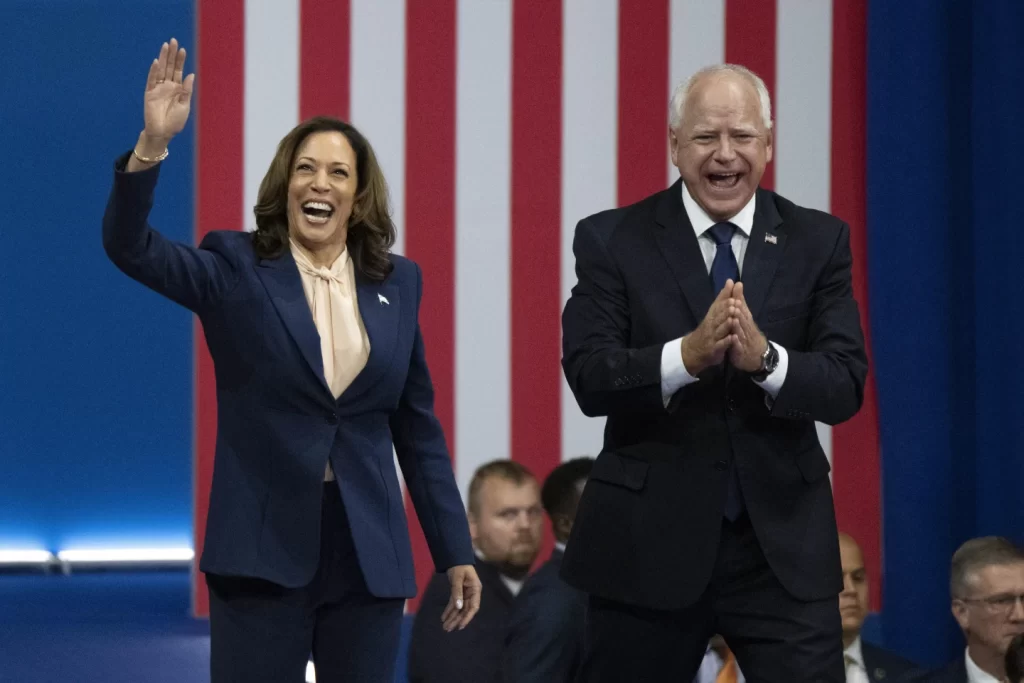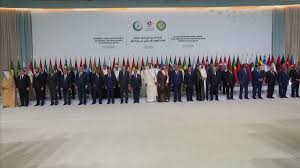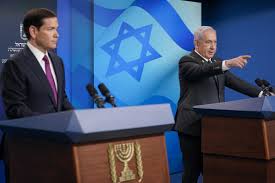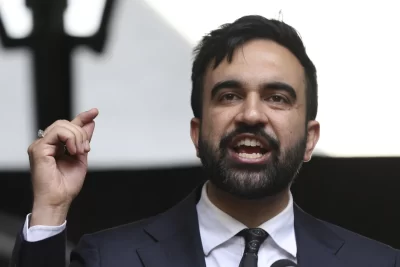
WASHINGTON — Kamala Harris’ whirlwind process to select Minnesota Gov. Tim Walz as her running mate can be summed up in a word: weird.
With President Joe Biden and Harris, his vice president, seeking a second term together, Democrats weren’t supposed to have a veep search at all. But as soon as the 81-year-old president ended his campaign and endorsed Harris, it was go time. And there was no playbook for the newly elevated candidate and a vetting team that in a normal campaign would have months, not days, to make such a critical decision.
What followed was a 16-day blitz on parallel tracks. There was the behind-the-scenes action: Harris lieutenants furiously researching contenders, the vice president debating options with top aides and confidants, and, finally, a weekend of interviews with finalists. And there was the public campaign: Contenders found every cable news camera, stumped in battleground states for the prospective boss, tried out attack lines on Republican nominee Donald Trump and his understudy, Ohio Sen. JD Vance — all while rival factions made their pitches and wielded their knives.
The whole thing was made more intense and conspicuous given the time constraints, highlighting the breadth of Democrats’ bench and, at the same time, the fragility of the party unity that defined Harris’ nascent White House bid. By the end, the process offered a preview of how Harris might fare under the pressures of the Oval Office, quickly working through options, with minimal leaks from her team and a result that, at least initially, has drawn plaudits from a party that seems intent on one undisputed goal: defeating Trump and Vance in November.
Here is a closer look at how Harris went from being Biden’s top deputy to selecting her own.
A phone call from Biden and a job for Holder and Remus
Biden called Harris on July 21 from his home state of Delaware, where the president had been isolating with COVID-19 and considering his political future while more and more Democratic officials called publicly and angled privately for him to leave the race. The president told Harris that he had indeed decided to end his campaign. Within hours, he’d released a letter on social media announcing his decision. And within an hour of that letter, Biden announced separately his endorsement of Harris.
The vice president had been careful in the weeks following Biden’s jolting debate performance against Trump not to say or do anything other than back the president. But that meant she had to make up ground. She inherited the Biden campaign infrastructure, the staff, even the money. But there was nothing set up for picking a running mate – Biden had already done that four years earlier.
Harris immediately tapped former Attorney General Eric Holder, a veteran of the Obama administration she had known well since her days as California attorney general, and Dana Remus, a former White House counsel for Biden, to lead the effort. Holder and a team of researchers and political veterans ultimately formally vetted nine choices -– perhaps a shorter roster than it would normally be for a monthslong process but still long enough to require phases and whittling before Harris got to the proverbial “short list.”
The public narrative asserted from the start that Harris, a biracial woman of Indian and Jamaican heritage who made history becoming vice president and would do so again if elected president, needed to balance the ticket demographically. In short, she needed a white man. Barack Obama, the nation’s first Black president, had gone this route with then-Sen. Joe Biden in 2008. Biden made a version of the same move in 2020 when he selected Harris.
Speculation quickly settled on a trio of governors: North Carolina’s Roy Cooper, Kentucky’s Andy Beshear and Pennsylvania’s Josh Shapiro. Illinois Gov. J.B. Pritzker got attention. The Washington contingent of contenders included Sen. Mark Kelly of Arizona and Transportation Secretary Pete Buttigieg.
Those familiar with the process said Harris and her team would consider both the practical matter of electoral politics and her personal comfort level with a potential governing partner.
Shapiro was seen as an early favorite because of his popularity in Pennsylvania, a critical battleground with 19 electoral votes that could block any path Trump might have to 270 electoral votes. A former state attorney general like Harris, Shapiro made sure to mention publicly that he’d known the vice president for nearly two decades.
Cooper got prominent mentions as a second-term governor in a state Trump won twice. His tenure as North Carolina attorney general was a boost: He had overlapped with Harris’ service in California, and the two had worked together on multistate lawsuits, making Cooper perhaps the only possible choice with whom Harris had worked closely in government. The two had campaigned together in North Carolina in the months before Biden ended his campaign.
Beshear got attention as a governor elected twice in a solidly Republican state, and for his takedowns of Vance as a poser who is not actually from Appalachia. “He ain’t from here,” the 46-year-old governor said of the even-younger senator.
Yet in a reminder that public impressions are rarely entirely wrong but even more rarely entirely right, as Cooper’s star rose in the public imagination, he privately told the Holder-Remus team that he did not want to be vetted for the national post, though that move would not be revealed publicly until days later.
Walz, meanwhile, was largely an afterthought. He was on the campaign’s extended list, just like he was included in media photo galleries circulated of possible running mates.
In the early days of the process, Michigan Gov. Gretchen Whitmer, one of the only women thought to be in contention and herself widely presumed to be a future presidential candidate, declared publicly that she wanted to help Harris as a campaign chairwoman, not as running mate.
An underappreciated jump-start for Walz
Walz had two jump-starts, the first largely unnoticed, the second underappreciated.
The first came earlier this year when the governor and the vice president visited a Planned Parenthood clinic in St. Paul. That trip underscored shared values between the two, according to people familiar with Harris’ thinking. Key issues that resonated with Harris included Walz’s advocacy for in vitro fertilization and child tax credits –- a policy Walz has used in Minnesota.
The next key moment came July 23, two days after Biden’s withdrawal, when Walz went on MSNBC’s “Morning Joe” and uttered a dig at Trump and Vance that quickly went viral.
“These guys are just weird,” Walz said, in his conversational, informal manner.
For years, Democrats, including Biden and Harris, have leveled high-minded attacks on Trump as a threat to democracy. They spotlighted his legal troubles, racist and sexist rhetoric, the hard-right policies found in the “Project 2025” agenda that Trump disavows. The jovial governor of Minnesota encapsulated it all in one word: “weird.” And he smiled while doing it.
Social media did its thing, and the Harris campaign took notice. Within days, the vice president -– and other vice-presidential contenders –- were using “weird” like an epithet.
By the first full weekend of her candidacy, the campaign circuit and cable news lineup was an open audition.
Pritzker sat for interviews, deflecting running-mate questions in one sentence and casually commenting in the next about how involved the vetting process was — his way of making sure the world knew he was on the list, short or not. He even released a campaign-style ad on Illinois’ successes (he’s not on the ballot this year, though he is the host governor of the upcoming Democratic National Convention in Chicago). Whitmer repeated her demurral but mused about how exciting it would be to have two women on the ticket.
On Sunday, July 28, Beshear traveled to Georgia, the state that produced the closest results in 2020, and sharpened his attacks on Vance and played up his ability to win in GOP areas even with solidly liberal policy credentials.
The following day, it was Shapiro’s turn in the Philadelphia suburbs, with Whitmer joining him on stage. Like Beshear, Shapiro touted Harris — and himself. “We get shit done in the commonwealth,” he boasted, rousing rallygoers with a stirring cadence that engenders comparisons to Obama.
At the same time the contenders were auditioning publicly, Holder and Remus were diving through contenders’ lives, private records and public statements. And Harris campaign aides were working double time on potential rollouts for those still in the running. They were led by campaign Chair Jen O’Malley Dillon.
For each possible choice, staffers planned everything from a hopscotch tour through battleground states to designing new campaign logos and drafting social media plans, surrogate interview lineups and talking points for party leaders.
Some duplicative work happens before any running mate pick, as a presidential nominee nears a final choice (think unused Clinton-Booker merchandise from 2016 or Trump-Rubio logos from a few weeks ago). But in this case, it almost certainly involved more combinations than usual.




